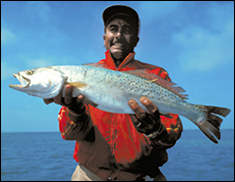|

The coastal fisheries biologists of the new millennium
are working hard to build a bigger, better trout for the 21st century. Here's how you can help them.
By Chester Moore, Jr.
Calling the
salty, Gulf water refreshing would've been an exaggeration, but
compared to the relentless August sun that beat down on us all
day, the change of environment was a welcomed relief.
My fiancée
Lisa Bartunek and I were fishing at an oil platform that sits
7 miles off of High Island when a large school of spadefish moved
in. We had caught and released several small sharks and were on
our way to a limit of Spanish mackerel. But seeing the spadefish
gave me other ideas.
I always carry
snorkeling gear and my Sea & Sea MX-10 underwater camera on
offshore trips, and since the water was smooth and clear, the
chance to photograph the pretty spadefish was too tempting to
resist. Each time I dove down to photograph the spades, I could
see a silver form about halfway down the platform leg. Curiosity
finally got the best of me, so I took a deep breath and went down
to see what it was.
As I descended,
the silver form took the shape of a fish. At first I thought it
might be a small kingfish or a wayward barracuda, but upon closer
examination it proved to be a speckled trout.
 A huge speckled trout. A huge speckled trout.
It took a second
for the magnitude of what I was looking at to set in. As I started
to run out of air and ascend, the fish swam right next to the
platform leg. It was nearly as long as the legs are wide! If this
fish wasn't 3 feet long and 13 or 14 pounds, it was real close
to being that big.
When I surfaced,
Lisa asked if I had seen a big shark or something. She said I
was as white as a sheet.
After telling
her what I had just seen, she explained to me that NOAA radio
had reported that a large thunderstorm was heading our way from
Galveston. We had to leave.
This squashed
my plans of going back down to photograph the fish, but I wasn't
about to argue with Mother Nature. A gray wall of angry-looking
clouds was building to the west and I could virtually feel the
barometric pressure dropping by the second.
On the way
home I could think of nothing but the monster trout I saw. Was
it a state record? Could I have caught it if we had stayed? Would
the fish be there when I went back? Why didn't I get a picture
of it?
Each question
seemed to spawn another and another until I found myself at home
that night watching a show on the Discovery Channel about bio-engineering,
and the scientists in Europe who are trying to create a "super
sheep," an animal that would grow much larger than the average
sheep and yield twice the wool.
Suddenly I
found myself thinking, "If they can create a 'super sheep',
why not a 'super trout'?"
After all,
the introduction of Florida bass genes have practically doubled
the size of bass in reservoirs throughout Texas and California.
Why couldn't scientists isolate the growth genes in speckled trout
and create a supreme subspecies to release into our bay systems?
Visions of
the monster trout I encountered underwater stayed with me as I
began a quest to learn more about the possibilities of the creation
of a super trout, making what may seem like science fiction now,
become reality in the future.
Define the Word "Super"
 The first step
of my quest was to define exactly what a super trout would be.
Make no mistake, a super trout would have to be a gargantuan fish.
I'm talking about a fish that would command serious respect in
a bay system, making schools of foot-long mullet really nervous.
Texas Parks & Wildlife Department (TPWD) officials have labeled
bass weighing 13 pounds or more as "lunkers," so I think
a speckled trout weighing more than 10 pounds would qualify as
a genuine "super trout." The first step
of my quest was to define exactly what a super trout would be.
Make no mistake, a super trout would have to be a gargantuan fish.
I'm talking about a fish that would command serious respect in
a bay system, making schools of foot-long mullet really nervous.
Texas Parks & Wildlife Department (TPWD) officials have labeled
bass weighing 13 pounds or more as "lunkers," so I think
a speckled trout weighing more than 10 pounds would qualify as
a genuine "super trout."
But size isn't
the only qualification. We're headed toward the millennium and
there are many questions to be asked in regard to the health of
our oceans, so this fish would have to be designed for the future.
The super trout would have to be a more pollution- and red tide-resistant
species than the run-of-the-mill speckled sea trout we have now.
This fish would have to be able to tolerate the worst polluted
areas-like the Houston Ship Channel- and red tide-prone areas-like
the Laguna Madre -to thrive in the 21st century.
continued
page 1 / page 2
| 




